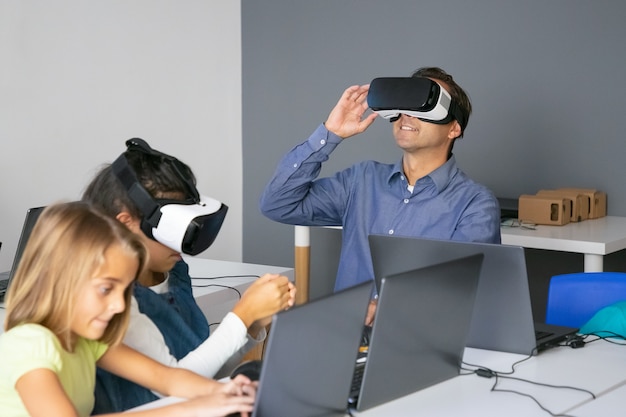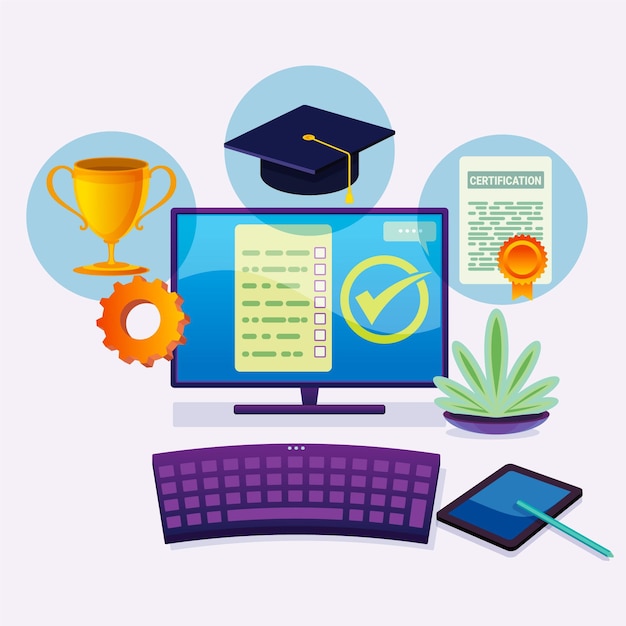Gamification’s In the educational geography of 2024,” Gamification’s Impact in Education” emerges as a lamp of invention, steering in a paradigm shift that transcends conventional tutoring methodologies. This title encapsulates the profound metamorphosis being at the crossroad of gaming dynamicsand educational practices.Gamification, formerly considered a bare pedagogical trial,has now come a important force driving pupil engagement and provocation. As we claw into this disquisition, we witness a departure from the traditional one- size- fits all approach to education. Gamification strategically integrates game rudiments into literacy gests , cultivating an terrain where scholars aren’t just unresistant donors but active actors in their educational trip.Our trip through the impact of gamification unfolds against the background of classrooms and virtual spaces, where preceptors and learners likewise embrace the eventuality of interactive and dynamic pedagogy.” Gamification’s Impact in Education” is further than a title; it signifies a cooperative trouble to review literacy, making it an immersive, satisfying, and substantiated experience.Join us in this disquisition as we navigate through the evolving geographies of education, revealing how gamification is reshaping the future of literacy, one achievement at a time. In 2024, education isn’t just a destination; it’s a witching trip where gamification paves the way for a new period of alleviation and academic excellence.
Why use gamification in education
The mix of gamification in training is driven by a significant comprehension of the developing necessities of contemporary students and an acknowledgment of the potential advantages it brings to the instructive scene. At its center, gamification takes advantage of the inherent inspiration and commitment that games normally summon. Understudies, especially in the computerized age of 2024, are familiar with intuitive and dynamic encounters. By integrating game components like focuses, identifications, and lists of competitors into the growing experience, teachers tackle these inspirational variables to establish a climate that spellbinds and supports understudy interest. Besides, gamification presents a component of rivalry, encouraging a solid pride and achievement as understudies progress through errands and difficulties. The quick criticism intrinsic in gaming encounters likewise gives an important learning component, permitting understudies to evaluate their presentation, distinguish regions for development, and emphasize on their comprehension.
Past inspiration and commitment, gamification in training tends to the individualized necessities of assorted students. By offering various pathways to progress and considering customized movement, gamified instructive stages take special care of various learning styles, speeds, and inclinations. This versatility advances inclusivity, it is abandoned to guarantee that no understudy. Besides, the cooperative and intuitive nature of numerous gamified learning conditions develops a feeling of local area among understudies. Whether through multiplayer challenges or cooperative missions, understudies can foster collaboration, correspondence, and critical thinking abilities, reflecting certifiable situations.
In the quickly changing scene of training, where conventional strategies might miss the mark concerning completely captivating the present educated students, gamification arises as a dynamic and viable arrangement. By taking advantage of the natural craving for challenge, accomplishment, and social connection, gamification in training addresses the “why” yet additionally fills in as an impetus for changing learning into a vivid, customized, and significant involvement with the homerooms of 2024.

Gamification in education examples
Gamification in education has evolved beyond theoretical generalities, with multitudinous real- world exemplifications showcasing its transformative impact on the literacy experience. One compelling case is the integration of gamified rudiments into literacy operation systems( LMS). Platforms like Kahoot! and Quizizz turn traditional quizzes and assessments into interactive games, fostering friendly competition and engagement among scholars. Another notable illustration lies in language literacy apps similar as Duolingo, where druggies embark on language searches, earn points, and unlock situations, making the accession of new language chops both amusing and educational.
also, the conception of” colophons” and” achievements” has gained traction in colorful educational settings. Classcraft, for case, introduces a part- playing game structure into classrooms, where scholars earn points and colophons for positive geste and academic achievements. This not only incentivizes good conduct but also encourages a sense of accomplishment and recognition. In advanced education, platforms like Coursera and edX use gamified progress shadowing, granting learners instruments and colophons upon course completion, adding a palpable and motivating aspect to online literacy.
Virtual Reality( VR) and stoked Reality( AR) have also witnessed gamification’s influence. Apps like Google peregrinations bring immersive gests into classrooms, turning assignments into witching virtual peregrinations. By gamifying the disquisition of literal spots or scientific generalities, scholars laboriously share in their literacy, fostering a deeper understanding of the subject matter.
Incorporating gamification into rendering education has proven particularly effective, as seen in platforms like CodeCombat. Then, scholars learn programming languages by working rendering challenges within a game terrain, enhancing their coding chops through hands- on, interactive gests . These exemplifications emphasize how gamification seamlessly integrates with colorful educational surrounds, transcending traditional boundaries and making learning a dynamic, pleasurable, and effective bid for scholars across different disciplines and age groups.

The Educational Landscape with Gamification’s Impact in 2024
As we navigate the instructive scene of 2024, the effect of gamification turns out to be progressively obvious, reshaping conventional standards and rethinking the elements of educating and learning. Gamification, at its center, addresses a combination of instructive standards with the enthralling components of games, introducing another period of commitment and inspiration inside homerooms. In this groundbreaking scene, understudies are presently not aloof beneficiaries of data however dynamic members in their learning process. Gamification decisively utilizes game components like focuses, identifications, and difficulties, establishing a vivid and dynamic climate that catches the consideration and excitement of students.
The year 2024 observers the incorporation of gamified opportunities for growth across different instructive levels, from elementary schools to advanced education establishments. Virtual and expanded reality advancements assume a crucial part in this development, rejuvenating subjects and offering understudies intelligent, three-layered investigations of mind boggling ideas. Furthermore, learning the board frameworks (LMS) have embraced gamification components, transforming routine assignments like tests and evaluations into connecting with exercises that advance solid contest and coordinated effort.
Moreover, the effect of gamification stretches out past the conventional homeroom setting, impacting the domain of online instruction. Computerized stages and instructive applications flawlessly integrate game elements to upgrade the growth opportunity, making illustrations more intuitive, charming, and viable. As understudies explore through journeys, acquire virtual rewards, and work together with peers, gamification builds up topic maintenance as well as develops basic abilities, for example, critical thinking, collaboration, and flexibility.
In this instructive scene of 2024, the reconciliation of gamification isn’t just a pattern yet an essential change by they way we approach schooling. It remains as a demonstration of the acknowledgment that learning isn’t restricted to reading material and talks however is an experiential and dynamic interaction. As gamification keeps on molding the instructive excursion, it makes ready for a future where understudies are scholastically capable as well as are likewise outfitted with the abilities and mentality important to flourish in a steadily developing world.

How does gamification affect learning
Gamification, as a pedagogical approach, wields a significant influence on learning issues by addressing the abecedarian aspects of pupil engagement, provocation, and skill development. One of the primary ways in which gamification affects literacy is through heightened pupil engagement. By incorporating game rudiments similar as points, situations, and interactive challenges into the educational experience, learners are drawn into a more dynamic and participatory terrain. This engagement is particularly pivotal in the digital age of 2024, where scholars are oriented to interactive and visually stimulating content.
provocation, a crucial determinant of successful literacy, is another area profoundly impacted by gamification. The natural prices bedded within games, similar as achievements, colophons, and progression, give scholars with immediate feedback and a palpable sense of accomplishment. This not only fosters a positive literacy experience but also instills a growth mindset, encouraging scholars to persist through challenges and view miscalculations as openings for enhancement.
Gamification’s influence on literacy extends beyond provocation to encompass the development of essential chops. Whether through cooperative searches or individual challenges, scholars laboriously share in problem- working, critical thinking, and decision- making processes. The interactive nature of gamified literacy gests cultivates a sense of autonomy, allowing scholars to explore and master content at their own pace. In addition, the competitive rudiments essential in gamification can inspire healthy battles among scholars, prodding them to exceed and constantly ameliorate their performance.
also, gamification promotes a positive literacy culture by transubstantiating the traditional classroom dynamic. scholars are no longer unresistant donors of information but active contributors to their own education. This shift from a schoolteacher- centered to a learner- centered approach encourages a sense of power and responsibility for one’s academic trip.
In conclusion, the impact of gamification on literacy ismulti-faceted, impacting engagement, provocation, and skill development. As educational geographies continue to evolve, the integration of gamification stands as a important tool, not only enhancing the literacy experience but also preparing scholars with the rigidity and adaptability needed for success in the complex and dynamic world of the 21st century.

Problems with gamification in education
While gamification in schooling has acquired prevalence for its capability to improve commitment and inspiration, it isn’t without its difficulties and reactions. One critical issue lies in the potential for extraneous inspiration to eclipse characteristic learning. Pundits contend that the emphasis on remunerations, like focuses and identifications, may urge understudies to focus on gaming components over a certified comprehension of the topic. At times, this could prompt a shallow commitment with content, where the essential objective becomes procuring rewards as opposed to dominating the material.
Another worry spins around the potential for inconsistent support. Understudies with fluctuating degrees of commonality and interest in gaming might answer contrastingly to gamified components, making differences in commitment and inspiration. This could coincidentally bar specific people or gatherings from completely profiting from the gamified growth opportunity, hence augmenting instructive imbalances.
Besides, the plan of gamified components requires cautious thought. Inadequately carried out gamification techniques might prompt disarray, interruption, or dissatisfaction among understudies. In the event that the game elements are not lined up with instructive targets or are excessively complicated, they might thwart as opposed to work with the growing experience.
There is likewise a gamble of distorting the instructive experience by decreasing complex ideas to game mechanics. Pundits contend that specific subjects, particularly those requiring profound decisive reasoning or applied understanding, might be mismatched for gamification. In such cases, gamification could think twice about profundity of advancing by focusing on superficial commitment over significant perception.
Furthermore, the overemphasis on contest through competitor lists and rankings can have unseen side-effects. While solid rivalry can be rousing, it might likewise establish a distressing climate, especially for understudies who are less cutthroat or flourish in cooperative settings. Finding some kind of harmony between sound contest and a strong learning local area becomes vital to try not to incidentally put a few understudies down.
All in all, the execution of gamification in training accompanies its arrangement of difficulties, including the potential for outward inspiration, inconsistent cooperation, plan issues, distortion of content, and unseen side-effects of rivalry. Tending to these worries requires insightful preparation, nonstop assessment, and a pledge to guaranteeing that gamification improves, instead of upsets, the general opportunity for growth.

Salesforce Progress in the Advanced Scene